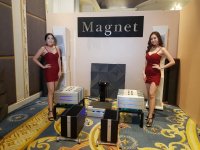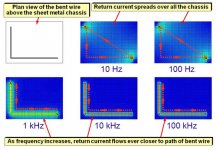Last edited:
JN,
Yes, thought of eddy currents and proximity effect earlier too, but wasn't ready to go there yet. Happy to have you mention it though.
Yes, thought of eddy currents and proximity effect earlier too, but wasn't ready to go there yet. Happy to have you mention it though.
It was not a jump. Bob showed a picture of a very corroded stranded wire.How did we get from wire/pcb copper oxide (diode) distortion to skin effect in one jump?
These sudden tangents are neck snapping.
-RNM
Everybody seems to believe there will be no current across the strands simply because the cross section is equipotential by transport current. Nobody is considering dI/dt and faraday's law.
Jn
Not inter-strand, rather inter-conductor (if XLR) and or conductor-to-shield capacitance.
That’s not how I understood your earlier post - but thanks for clarifying
Once again, claim without supporting evidence.Again, we are talking about small effects that are audible to some people and or audible under some not-uncommon real world conditions.
This is a fundamental tenet within the discipline of EMC. It is included within Tom Van Doren's lecture series.some would be surprised to know this effect occurs at very low/audio frequencies. Many have insisted it only occurs above audio.
[wire over ground plane]
View attachment 815408
THx-RNMarsh
It is also how many designers screw up the final details of an amplifier build.
The effect is actually the current slew rate attempting to lower the loop inductance. This is also why even zip cable will force the currents to prefer the side of the conductor closest to the other conductor.
Jn
How did we get from wire/pcb copper oxide (diode) distortion to skin effect in one jump?
These sudden tangents are neck snapping.
-RNM
Damir's amps are up and running at local show.
View attachment 815396
Them amps have quite a bit of neck snapping skin effect! 😛
Seems to be one of those topics where we start the discussion in every iteration at zero. 🙂
I'm still wondering about Scott Wurcer's and gpapag's jump from sudden awareness of a part in a soundfield to unreliable "sighted listening" and bad auditory memory.
Doesn't it remind to the "gorilla in our midst" ?
If someone missed the "gorilla" in the first round and in a repetition suddenly detects it, wouldn't he also be sure that it wasn't there before?
Is it then a matter of an unreliable iconic memory?
It IMO just underscores why it is so important to be prepared as a participant in any evaluation task (means training to learn how to listen and what for to listen overall and especially under the specific experimental conditions) and why any experiment design needs a lot of consideration.
In fact there is a little connection to the question of "blind" vs. "sighted" but more to fundamentals of how our brain and mind work.
As stated before, some experiments are routinely done without letting the participants know what the EUT really is. There is good reason for this procedure but of course there are others that can be used too.
I'm still wondering about Scott Wurcer's and gpapag's jump from sudden awareness of a part in a soundfield to unreliable "sighted listening" and bad auditory memory.
Doesn't it remind to the "gorilla in our midst" ?
If someone missed the "gorilla" in the first round and in a repetition suddenly detects it, wouldn't he also be sure that it wasn't there before?
Is it then a matter of an unreliable iconic memory?
It IMO just underscores why it is so important to be prepared as a participant in any evaluation task (means training to learn how to listen and what for to listen overall and especially under the specific experimental conditions) and why any experiment design needs a lot of consideration.
In fact there is a little connection to the question of "blind" vs. "sighted" but more to fundamentals of how our brain and mind work.
As stated before, some experiments are routinely done without letting the participants know what the EUT really is. There is good reason for this procedure but of course there are others that can be used too.
Last edited:
That doesn't appear to be what Scott was asking about?Don't know. Maybe capacitive coupling to other balanced conductor and or shield creates some lateral EMF. Again, we are talking about small effects that are audible to some people and or audible under some not-uncommon real world conditions. Probably small EMF involved.
That doesn't appear to be what Scott was asking about?Skin effect, by definition, requires current across the strands.
Wow, leave for a week or two...
Jn
Them amps have quite a bit of neck snapping skin effect! 😛
Huh? What amps?
Jn
Yes, it is.That doesn't appear to be what Scott was asking about?
He has assumed that there cannot be any current between strands because there is no voltage between them as a result of transport current and transport current IR drop. His statement neglects dI/dt and the toroidal induced currents.
Within a zip pair, the maximum internal inductance is 30 nH per foot, so the total energy available to get messed up as noise by a heavily oxidized cable is certainly measurable yet small.
What everybody misses is the proximity effect can easily halve the zip inductance. That is roughly 100 nH per foot. Heavily oxidized stranded zip will generate far more noise and non linearity by proximity effect.
The fact that we typically use high z zip for low z loads , thereby forcing current dominated energy storage does not help.
Jn
Last edited:
[/To view 【€ 91,20 6% Off | Nordost Odin Supreme Reference Interconnect audio cable interconnect cable RCA WBT-0152Ag connector vinshle】 on AliExpress with code #_UOa2w#, copy the whole sentence and open the app.
Hans
Thanks. I'm out skiing and getting ready to confront the upcoming Sabrina storm. I'll look into it if I make it back alive. 🙂
Yes, it is.
He has assumed that there cannot be any current between strands because there is no voltage between them as a result of transport current and transport current IR drop. His statement neglects dI/dt and the toroidal induced currents.
Within a zip pair, the maximum internal inductance is 30 nH per foot, so the total energy available to get messed up as noise by a heavily oxidized cable is certainly measurable yet small.
What everybody misses is the proximity effect can easily halve the zip inductance. That is roughly 100 nH per foot. Heavily oxidized stranded zip will generate far more noise and non linearity by proximity effect.
The fact that we typically use high z zip for low z loads , thereby forcing current dominated energy storage does not help.
Jn
We were talking about multiple strands down one of the conductors and that’s why Scott mentioned the 10mV figure and I then questioned Mark on how you could have ‘lateral EMF’ when there was no voltage differential between the strands (oxidized or not) at any point along the conductor.
We were talking about multiple strands down one of the conductors and that’s why Scott mentioned the 10mV figure and I then questioned Mark on how you could have ‘lateral EMF’ when there was no voltage differential between the strands (oxidized or not) at any point along the conductor.
I know exactly what both of you stated. And that is what I responded to.
With DC, there will be no voltage differential between strands.
You still confuse transport current IR drop with the dI/dt induction between strands.
Jn
Regarding multiple stranded wires where each strand are not isolated, isn't it so that electrons wants to take the straightest path which means for twisted multi strand wire the electrons would at some point jump from strand to strand, but when the strands starts to oxidizes that's when the "problem" starts to appear when the potential charge to make the jump from one oxidized strand to another one increases and the so called "diode effect" starts to make its appearance, and the electrons have to instead move along the twisted path of the strands.
However, I am not saying a twisted multi stranded wire is better, I would advocate for non twisted design if going with multi stranded wires.
However, I am not saying a twisted multi stranded wire is better, I would advocate for non twisted design if going with multi stranded wires.
Is there a voltage difference between adjacent strands on a speaker conductor (let’s assume 3 m for the sake of argument) if at both ends the strands are shorted and at frequencies up to say 100 kHz?
Genuine question.
Genuine question.
More to point is.....are there currents between adjacent strands.Is there a voltage difference between adjacent strands on a speaker conductor (let’s assume 3 m for the sake of argument) if at both ends the strands are shorted and at frequencies up to say 100 kHz?
Genuine question.
If you go back to that wiki skin effect page, note the third figure down on the right. They depict transport current ("I") and Eddie currents ("Iw").
If Iw has a very messy path, it will mess up transport current distribution and consequently the internal inductance (mag field lines depicted as "H").
Inter strand voltage per se is meaningless, as the depicted Iw toroids are uniformly distributed along the wire axially as well as around the wire section. One can only measure the net transport current profile radially.
Jn
Last edited:
- Status
- Not open for further replies.
- Home
- Member Areas
- The Lounge
- John Curl's Blowtorch preamplifier part IV

